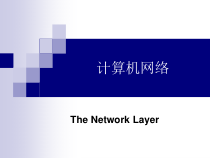 PPT
PPT
【文档说明】计算机网络第五版(英文版)(5)解析课件.ppt,共(75)页,3.546 MB,由小橙橙上传
转载请保留链接:https://www.ichengzhen.cn/view-5179.html
以下为本文档部分文字说明:
计算机网络TheNetworkLayerTheNetworkLayerTopicsNetworkLayerDesignIssuesStore-and-ForwardPacketSwitchingImplementationo
fConnectionlessServiceImplementationofConnection-OrientedServiceComparisonofVirtual-CircuitandDatagramSubnetsRoutingAlgorithmsCorrectne
ssSimplicityRobustnessStabilityFairnessOptimalityRoutingAlgorithmsShortestPathRoutingFloodingDistanceVectorRoutingLink
StateRoutingHierarchicalRoutingRoutingAlgorithmBasicsTheroutingalgorithmisthatpartofthenetworklayersoftware
responsiblefordecidingwhichoutputlineanincomingpacketshouldbetransmittedon.Ifthesubnetusesdatagramsinternally,thisdecisionmustb
emadeanewforeveryarrivingdatapacketsincethebestroutemayhavechangedsincelasttime.Ifthesubnetusesvirtualcircuits
internally,routingdecisionsaremadeonlywhenanewvirtualcircuitisbeingsetup.RoutingAlgorithmBasics(2)AlloptimalroutesfromstationA
tootherstationsinthenetwork,jointlyconstituteasinktreeRoutershavetocollaboratetobuildthesinktreeforeachsourcestationordestinationstation.RoutingAlg
orithmBasics(3)MetricsusedforoptimizationDistanceNumberofhopsTimedelayTwomajorclassesofroutingalgorithmsNonadaptiveorStatic
:theroutingtableiscomputedinadvance,off-line,anddownloadedtotherouterswhenthenetworkisbooted.AdaptiveorDynamic:changetheirroutingdecisionstor
eflectchangesinthetopology,andusuallythetrafficaswell.ShortestPathRoutingIdea:buildagraphofthesubnet,witheachnodeofthegraphrepresentingar
outerandeacharcofthegraphrepresentingacommunicationline.Tochoosearoutebetweenagivenpairofrouters,thealgorithmjustfindstheshortestpathbetwe
enthemonthegraph.thelabels(weights)onthearcscouldbecomputedasafunctionofthedistance,bandwidth,averagetraffic,commu
nicationcost,measureddelay,andotherfactors.ShortestPathCriteria:sumoftheweightsalltheway,or,thenumberofhops.Sho
rtestPathRoutingDijkstraAlgorithmBasicIdea:duringeachstep,selectanewlyreachablenodeatthelowestcost,andaddtheedgetothatno
de,tothesinktreerootedatthesourcenodebuiltsofar.FloodingBasicidea:Forwardanincomingpacketacrosseveryoutgoi
ngline,excepttheoneitcamethrough.Basicproblem:howtoavoid―drowningbypackets‖?Useahopcounter:afterapackethasbeenforwar
dedacrossNrouters,itisdiscarded.Besuretoforwardapacketonlyonce(i.e.avoiddirectedcycles).Requiressequencenumberspersou
rcerouter.Floodselectively:onlyinthedirectionthatmakessense.Floodingmakessenseonlywhenrobustnessisneeded,e.g.inmilit
aryapplicationsDistanceVectorRoutingBellman-FordorFord-FulkersonalgorithmDistanceVectorRoutingAlgorithms:eachroutermaintainsatable(
i.e,avector)givingthebestknowndistancetoeachdestinationandwhichlinetousetogetthere,whichareupdatedbyexchanginginfor
mationwiththeneighborsperiodically.UpdatingProcess:Takealookatthecoststhatyourdirectneighborsareadvertisingtogetapackett
othedestination.Selecttheneighborwhoseadvertisedcost,addedwiththecosttogettothatneighbor,isthelowest.Advertisetha
tnewcosttotheotherneighbors.InDVR,thereistheproblemofcount-to-infinityinthepresenceofnodecrashes.DVRExam
ple(a)Asubnet.(b)InputfromA,I,H,K,andthenewroutingtableforJLinkStateRoutingLinkStateRouting:broadcastinfoontheentirenetworktopologytoa
llrouters,andleteachofthemcalculateasinktreetotheotherrouters.Eachroutermustdothefollowing:Discoveritsneighbors,learntheirnetworkadd
ress.Measurethedelayorcosttoeachofitsneighbors.Constructapackettellingallithasjustlearned.Sendthispac
kettoallotherrouters.Computetheshortestpathtoeveryotherrouter.MeasuringLineCostJustsendanECHOpacketthrougheachinterface,andmeasuret
heround-tripdelay.That’llgiveyouareasonableestimateoftheactualdelay.Whethertotaketheloadintoaccountwhenmeasuringthedelay?Yes:
thetimershouldbestartedwhentheECHOpacketisqueued.Youmayredirecttrafficinsuchawaythatthealternativerouteisunloaded.No:thetimershouldbes
tartedwhentheECHOpacketreachesthefrontofthequeue.Theshortestpathyouchoosemaybeoverloaded.BuildingLinkStatePacketsThepacketstartswiththei
dentityofthesender,followedbyasequencenumberandage,andalistofdualitems(neighbor,thedelaytoit).Thehardpartiswhento
buildthem,atregularintervalsorwhensomesignificanteventoccurs?Practiceshowsthatonceanhourisoftenenough.DistributingtheLinkStatePacketsUseafloodi
ngalgorithm,anddamthefloodthroughsequencenumbers:allroutersmaintainalistof(source,seqnumber)-pairs.Tosafeguardagainstolddata,downlinks,etc.ana
geisaddedtoanLSP.Theageisdecrementedonceasecond,andeverytimeitisforwardedbyarouter.Whentheagehitszer
o,theLSPisdiscarded.Toguardagainsterrorsontherouter-routerlines,alllinkstatepacketsareacknowledged.Goodsand
BadsofLSRGoodsGoodconsistencyofeachrouterinformationQuickconvergenceforgoodandbadnewsBadsEachrouterneedlargememorytostoretheinputlin
kstatesofotherroutersThecomputationtimecanbeanissueHierarchicalRoutingProblem:Noroutingalgorithmdiscussedsof
arcanscale:allofthemrequireeachroutertoknowaboutallothers=>toodemandingwithrespecttomemorycapacityandprocessingpower.Gof
orsuboptimalroutesbyintroducinghierarchicalroutingandregions,andseparatealgorithmsforintra-regionandinter-regionrouting.Example:Hierarchica
lRoutingMulticastingroutingMOSPFDVMRPCBTNextdiscussiontopicsMulticastingroutingAdhocroutingBroadcasti
ngroutingMobilehostsroutingCongestionControlAlgorithmsGeneralPrinciplesofCongestionControlCongestionPreventionPoliciesCongestionControlinVir
tual-CircuitSubnetsCongestionControlinDatagramSubnetsLoadSheddingJitterControlCongestionCongestion:Whe
ntoomanypacketsarepresent,performancedegradesAtveryhightraffic,performancecollapsescompletelyandal
mostnopacketsaredelivered.CongestionGeneralPrinciplesofCongestionControlTwogroupsofsolutions:Openloop:attempttosolvet
heproblembygooddesign,inessence,tomakesureitdoesnotoccurinthefirstplace.Closedloop:arebasedontheconceptofafeedbackloo
p.Monitorthesystemtodetectwhenandwherecongestionoccurs.Passinformationtowhereactioncanbetaken.Adjustsystemoperationtocorr
ecttheproblem.PolicyCongestionControlinVirtual-CircuitSubnetsHop-by-HopChokePacketsWhenarouterrunsoutofitsresources,it
sendsachokepacketbacktothesourcehost,givingitthedestinationfoundinthepacket.Whenthesourcehostgetsthechokepacket,itwillslowdownthetrafficse
nttothespecifieddestination.Hop-by-Hop:thechokepacketaffectseveryhopitpassesthrough.(a)Achokepacketthataffec
tsonlythesource.(b)Hop-by-Hopchokepacket.RandomearlydetectionByhavingroutersdroppacketsbeforethesi
tuationhasbecomehopeless(hencethe''early''inthename),theideaisthatthereistimeforactiontobetakenbeforeitistoolate.Tode
terminewhentostartdiscarding,routersmaintainarunningaverageoftheirqueuelengths.Whentheaveragequeuelengthonsomelineexceedsathreshol
d,thelinkissaidtobecongestionandasmallfractionofthepacketsaredroppedatrandomJitterControlQualityofServiceAstreamofp
acketsfromasourcetoadestinationiscalledaflow.Inaconnection-orientednetwork,allthepacketsbelongingtoa
flowfollowthesameroute;inaconnectionlessnetwork,theymayfollowdifferentroutes.Theneedsofeachflowcanbecharacterizedbyfourprimaryparameters:reli
ability,delay,jitter,andbandwidth.TogetherthesedeterminetheQoS(QualityofService)theflowrequires.TrafficShapingTrafficshapingis
aboutregulatingtheaveragerateofdatatransmission.Thegoalistoallowapplicationstotransmitawidevarietyoftraffi
cthatsuitstheirneeds,includesomebursts.TheLeakyBucketAlgorithmImagineabucketwithasmallholeinthebottom.Nomattertherateatwhichwaterente
rsthebucket,theoutflowisataconstantrate,,whenthereisanywaterinthebucketandzerowhenthebucketisempty.*实现:
-对定长分组的实现:以分组为单位;-对变长分组的实现:采用字节计数法。漏桶算法(续):*举例:设计算机以25MB/s速率产生数据,路由器长时间的最佳工作速率不超过2MB/s。数据以每秒中有40ms,1MB的突发数据输入。为平稳输出,使用一个ρ=2MB/s,容积C=1MB的漏桶
。a图为漏桶的输入,b图为漏桶的输出。TheTokenBucketAlgorithmTheleakybucketalgorithmenforcesarigidoutputpatternattheaveragerate,nomatterhowburstythetrafficis.For
manyapplications,itisbettertoallowtheoutputtospeedupsomewhatwhenlargeburstsarrive,soamoreflexiblealgori
thmisneeded,preferablyonethatneverlosesdata.Onesuchalgorithmisthetokenbucketalgorithm.通信量整形—令牌桶算法:*实现:-采用分组计数法:设置令牌计数器,每隔ΔT加1,每发送一个分组减1,计数器为0时停止发送。
-采用字节计数法:时钟每隔ΔT令牌计数器加k字节,每发送一个分组减该分组长度。*对突发时间长度的限制:设突发时间长度S秒,令牌桶容量B字节,令牌到达率R字节/秒,最大速率M字节/秒,由B+RS=MS得S=B/(M-R)。通信量整形—令牌桶算法:*对突发长度的限制(续):例:容量
C分别是250KB、500KB和750KB,ρ=2MB,M=25MB/s。假定当1MB突发数据到达时,令牌桶已满。5.4.2实现高QoS的技术(续)资源预留:•可能被预留资源的种类:-带宽-缓冲区空间-CPU时钟周期AdmissioncontrolAdmissioncontrol:
•确定接收或拒绝一个流并非易事,原因:-由于有些应用可能知道带宽需求,但不知道缓冲区和CPU时钟周期的需求。-有些应用需要更高的容错能力。-有些应用希望讨价还价流的参数。Admissioncontrol•flowspecification(流说明):-能够准确描述规范化的流参数。
-从源端到目的端沿途路由器可修改这些参数。举例:-令牌桶速率:长时间间隔的平均输入桶的每秒字节数。-令牌桶容量。-峰值数据速率:限制短暂时间间隔发送速率。-最小、最大分组长度:含头部。Packetsscheduling按比例路由:由于路由器一般不
了解整个网络的流量,一种高QoS的方法是根据输出链路能力按相等或比例划分,在多条路径上传输。Packetsscheduling:•公平队列算法:*Nagle算法:-到达分组按分类或流进入各自队列;-轮流从各队列输出,一旦某队列空,
立即从非空队列输出。Packetsscheduling分组调度(续):•公平队列算法(FIFO)•加权队列算法(WFQ)5.4.2实现高QoS的技术(续)分组调度(续):•加权公平队列(WFQ):-对不同的队列设置优先级(即权重)。-按权重比例
发送。5.4.2实现高QoS的技术(续)分组调度(续):•令牌+WFQ提供可证明的最大队列延时:n条流的令牌桶+WFQ队列模型。b1r1bnrnw1wnInternetworkingHowNetworks
DifferHowNetworksCanBeConnectedConcatenatedVirtualCircuitsConnectionlessInternetworkingTunnelingFragmentationConnectingNetworksHowNetw
orksDifferHowNetworksCanBeConnectedRepeatersatthephysicallayerforboostingsignals.Bridgestomaketheinterconnectionatthedatalinklayer.Mul
tiprotocolroutersforforwarding,andpossiblysplittinguppackets(bridgescan’tdothelatter).Transportgateways
forinterfacingbetweentwotransportconnections.Applicationgateways,translatemessagesemantics.ConcatenatedVirtualCirc
uitsConnectionlessinternetworkingHavethenetworklayerofferonlydatagramservices:unreliable,unorderedpacketflow.Mainproblem:Addressing–differentnetwor
ksusecompletelydifferentaddresses,sohowdoIaddressahostinanIPnetworkwhenI’veonlygotSNA?Solution:consider,usingIPasauniversal
networkprotocolTunnelingWecansolvealotoftheinternetworkingproblemswhenwecanassumethatthesourceanddestinationofthesametypeo
fnetworkisconnectedbydifferentnetwork,weneedonlytotunnelpacketsthroughintermediatenetworks.FragmentationFra
gmentation:Differentnetworksmayimposedifferentmaximumpacketsizes.Thismeansthatwemayhavetosplitapacketintosmalleronesw
henforwardingitthroughanetworkwhosemaximumpacketsizeistoosmallWheretoreassemblethefragments?Gateway:TransparentfragmentationThedestinationhost
:NontransparentfragmentationTheNetworkLayerintheInternetTheInternetProtocol(IP)TheInternetisacollectionofmanynetwo
rksconnectedtogetherbyabunchofbackbones.ThegluethatholdsthewholeInternettogetheristhenetworklayerprotocol,IP(InternetProtocol).TheIPv4HeaderTheIP
v4Header(2)AddressesIPAddresses(2)Subnets(1)Allhostsonthesamenetworkmusthavethesamenetworknumber.Thismaycauseasingleorganizationtoacquiresev
eralclassesofaddressesformultipleLANs.Useasinglenetworkaddressfortheentireorganization,andinternallydividethehosta
ddressspaceintoasubnetaddressandahostidToimplementsubnetting,themainrouterneedsasubnetmaskthatindicateCIDR–ClasslessI
nterDomainRoutingCIDR–ExamplesCIDR–AggregateEntriesFormanyroutersoutside194.24.0.0,theonlythingtheyseeisthatt
hereare(atleast)3networkaddressesforwhichpacketsfollowthesameroute.Theseentriescanbeaggregatedintoasingleentry194.24.0.0/19withasinglesubmaskof19
/131/0bits.
 辽公网安备 21102102000191号
辽公网安备 21102102000191号
 营业执照
营业执照